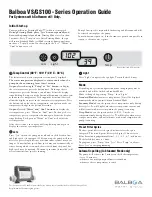
© Wikora GmbH
Page 5
As of 6/22/2015
Errors excepted.
5 Installation
All pipes connecting to the tank should have removable connections (fitting/flange). Pipe thread seals with teflon are to
be avoided.
All tank connecting pipes are to be planned, constructed and tested according to the technical rules in force, as well as to the
corresponding norms and regulations in accordance with their application and supply medium.
Appropriate filters should be used to prevent dirt or particles from entering the tanks. Moreover, the tank should be ensured
against pressure fluctuations and excess pressure through the installation of tested pressure reducing valves and safety
valves.
Sensors and thermostats necessary for temperature control must be securely and permanently positioned on the tank
(immersion sleeve and sensor rail).
The tank’s venting and draining facilities must have the appropriate dimensions and be correctly installed.
The installation company is responsible for the correct execution of work and for the safe and careful insulation of the pipes.
When connecting to a solar plant, a temperature limiter is required and must be installed on site at the hot water outlet
in order to prevent scalding.
Safety valve
Drain pipe
Safety group according to
DIN 1988
S
top
valve
S
top
valve
M
ano
m
ete
r c
onnectio
n
B
ac
kfl
ow
pr
event
er
T
es
t v
alve
P
res
su
re
red
uc
ing
valve
HW
Circulation
CW
D
rain
Water plug
Connection Scheme
Hotwater-
mixer
Anode
Sensor-
socket
Illustration 2 (Schematic diagram)
The size of the DHW safety valve is shown below:
Content of DHW space
Min. valve size
Max. heating performance
up to 200 l
NW 15 (1/2“)
75 kW
above 200 to 1000 l
NW 20 (3/4“)
150 kW
When installing a circulation pipe, the plug in the flange cover must be replaced by a circulation connection attachment (plastic
immersion pipe with double nipple R ¾”, Wikora part number 096 090).
The thread diameter of the heating safety valve depends on the nominal capacity of the water space and the maximum heating
capacity of the heat generator. It can be determined as follows:
Reaction pressure
Max. heating capacity of the heat generator
1,5 bar
36 kW
72 kW
144 kW
252 kW
433 kW
650 kW
2,0 bar
43 kW
86 kW
172 kW
302 kW
518 kW
778 kW
2,5 bar
50 kW
100 kW
200 kW
350 kW
600 kW
900 kW
3,0 bar
56 kW
112 kW
224 kW
395 kW
678 kW
1017 kW
Thread diameter (inch)
1/2
¾
1
5/4
6/4
2
Illustration 3 (Schematic drawing
– example hydraulic system heating)



























